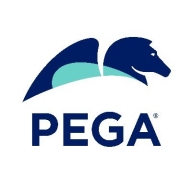

Pega Platform and IBM BPM are leading competitors in the business process management software market. Pega holds an advantage due to its highly integrated features that reduce the need for customization.
Features: Pega Platform offers seamless cloud implementation, rapid configuration capabilities, and strong case management and integration services. Its unified architecture simplifies complex processes, making it adaptable for enterprise solutions. On the other hand, IBM BPM provides powerful process modeling and integration tools, which are advantageous for managing complex workflows and enhancing collaboration.
Room for Improvement: Pega Platform's complexity often requires experienced developers, and its high cost can be a barrier for smaller businesses. Enhancing RPA and AI capabilities, alongside better cloud integration, are areas for improvement. IBM BPM users desire easier UI customization and better integration features. Both products could optimize pricing models to increase accessibility and improve deployment simplicity.
Ease of Deployment and Customer Service: Pega offers multiple deployment models, including cloud and on-premises, but faces challenges in setup complexity and resource demands. While its customer support is generally good, improvement in responsiveness is needed. IBM BPM's primarily on-premises model limits scalability, and although support is competent, there is room for more proactive assistance during upgrades and integrations.
Pricing and ROI: Pega's high pricing may deter medium and small enterprises despite its robust features and significant ROI justification. Its cloud option aids efficient setup for small businesses. IBM BPM is perceived as expensive, suited for larger organizations, with additional customization costs potentially impacting total ownership cost. Despite this, some organizations report good long-term ROI from process efficiency enhancements.
The customer service is outstanding.
On a scale from 1 to 10, support deserves a rating of 7 to 8.
We had a contract that provided on-site support, which was very satisfactory.
The technical support from Pega is very low, rating a one or two out of ten.
I never needed support from the platform standpoint, but if additional features are required, we have regular meetings with the product team for feedback.
Pega's technical support team is very helpful.
The solution has scalability issues; on a scale, I would rate it at eight out of ten.
The architecture of the solution offers scalability; we can scale both vertically and horizontally.
I found IBM BPM to be scalable to a certain level but it struggled with large volumes of concurrent transactions.
Currently, big banking providers and insurance providers, even the members for healthcare payers, are using more than millions of operations on a daily or weekly basis.
IBM BPM also lacks smaller solutions, so I must purchase multiple solutions to start with workflows and applications.
Although IBM BPM is a substantial product, adopting and integrating new technologies quickly is not easy due to the migration and upgrade paths involved.
With the recent development of AI agents in Pega Platform 24.2, the adoption is not heavy due to regulations around using external LLM by customers, especially regulated customers in BFSS and healthcare.
Pega introduced Constellation, which allows a user to build a more engaging visual experience.
My learning curve in robotics has been challenging.
SAP is more expensive, but IBM BPM is very expensive.
Pega is priced higher than open-source options like Flowable but is suitable for large-scale industries like banking and insurance.
The pricing is expensive, and this is an issue.
From a licensing perspective, it is higher than the competition.
The integration capabilities of IBM BPM are excellent.
Management capabilities such as dashboards.
Pega Platform is excellent for enterprise-level solutions with integrations to entire systems, including case management, service orchestration, CRM, decision-making capabilities, digital process automation, and AI-driven functionalities.
| Product | Market Share (%) |
|---|---|
| Pega Platform | 5.0% |
| IBM BPM | 5.3% |
| Other | 89.7% |


| Company Size | Count |
|---|---|
| Small Business | 30 |
| Midsize Enterprise | 19 |
| Large Enterprise | 71 |
| Company Size | Count |
|---|---|
| Small Business | 9 |
| Midsize Enterprise | 15 |
| Large Enterprise | 68 |
IBM BPM is a business process management tool that provides a robust set of tools to author, test, and deploy business processes, as well as full visibility and insight to managing those business processes. The solution provides tooling and run time for process design, execution, monitoring, and optimization, along with basic system integration support. To support various levels of complexity and involvement with business process management, there are two different editions of the product: IBM BPM and IBM BPM Express.
IBM BPM Features
IBM BPM has many valuable key features. Some of the most useful ones include:
IBM BPM Benefits
There are many benefits to implementing IBM BPM. Some of the biggest advantages the solution offers include:
Reviews from Real Users
IBM BPM is a solution that stands out when compared to many of its competitors. Some of its major advantages are that it’s good for developing complex apps, is robust, and has helpful team management and process performance features.
Zoran C., Owner/CEO at IT SPHERE, says, “It is perfect if you have to develop complex apps without much coding (only java script). It is also good if you don't have much IT resources in your company and would like to involve business analysts in the process of developing apps. My opinion is that it can do about 50% of all developers' work.”
Suhas V., BPM Architect at GBM, mentions, “Overall the solution is robust and has the ability to integrate with any product for complex workflows."
A BPM Consultant at a financial services firm comments, "Some of the features that I like the most are team management and process performance. They are both very useful and very powerful with regard to the workflow."
A Digital Banking & Innovation Director at a financial services firm expresses, “The processing functionality makes it easy to change processes and workflows easily.”
Pega Platform provides flexible business process management with a focus on rapid application development and automation through a low-code approach, enhancing efficiency across sectors.
Pega Platform is renowned for its ability to streamline operations with robust automation features, including robotic process automation and decision-making capabilities. Its intuitive interface and workflow management contribute to a reputation for enhancing business processes. Although users face challenges with integration limitations and high licensing costs, they benefit from rapid deployment and efficient process adaptations. The unified architecture reduces complexity, while case management and integration services support digital transformations in sectors such as banking, insurance, and healthcare.
What are the key features of Pega Platform?In industries like insurance, banking, healthcare, and government, Pega Platform is implemented to automate diverse workflows, supporting initiatives from claims processing to customer onboarding. Enterprises use Pega for case management and digital transformations, valuing its out-of-the-box integrations and real-time reporting capabilities to boost operational automation and enhance customer experiences.
We monitor all Business Process Management (BPM) reviews to prevent fraudulent reviews and keep review quality high. We do not post reviews by company employees or direct competitors. We validate each review for authenticity via cross-reference with LinkedIn, and personal follow-up with the reviewer when necessary.